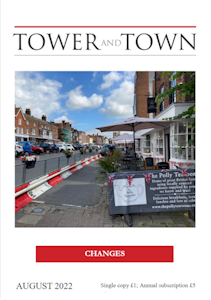

Tower and Town, August 2022 (view the full edition) (view the full edition)Isabel Of Gloucester - A Remarkable Woman (pt I)
Isabel was earl William of Gloucester's youngest daughter. Her only brother died in 1166, leaving her and her two sisters, Mabel and Amice, to inherit the earldom of Gloucester. Isabel's paternal grandfather, Robert of Gloucester, illegitimate son of King Henry I, had sided with his half-sister, Queen Matilda, in the civil war known as the Anarchy, against King Stephen. Robert came to Marlborough Castle in 1140 to take a prisoner there, the Flemish mercenary Robert Fitz-Hubert, to Devizes castle where he had Fitz-Hubert hanged in front of his men for treachery. Isabel would not have known her ruthless grandfather as he died in 1147 some 13 years before she was born. The marriage agreement for John and Isabel was made at Windsor on 28th September 1176 with John's father, King Henry II, and Isabel's father, earl William of Gloucester. Isabel's sisters, Mabel and Amice, were by then married leaving Isabel the only unmarried daughter. It was agreed that John would become the heir to the earldom of Gloucester. Mabel and Amice were granted £100 annuities as compensation for losing their inheritance. King Henry promised to arrange an appropriate marriage for Isabel in the unlikely instance that the pope was to refuse a dispensation for the cousins to marry. It was also agreed that if earl William was to have a son, John would share Gloucester with him. John was betrothed to Isabel when he was only 9 years old. Isabel was about 16, we don't know exactly when she was born. They had to wait: girls could marry at 12 and boys at 14. Earl William died on 23rd November 1183. John would acquire, on his marriage, the county of Gloucester1. King Henry II had arranged the betrothal in the knowledge that his son would one day have substantial lands of his own and no longer deserve his nickname, "John Lackland".
However, Baldwin, the Archbishop of Canterbury, opposed the marriage because of the three degrees of consanguinity2. But the marriage went ahead anyway. After all, few would have gone against King Henry II, John's father. The fate of Baldwin's predecessor, Thomas Becket, who stood up to Henry II, would have been remembered. Becket had been brutally murdered by four knights in Canterbury cathedral on 29th December 1170. Writs condemning Becket had been sent out in December 1164 from Marlborough castle, where Henry spent Christmas that year. But Henry was dead. Would the new king, Richard the Lionheart, back his brother's marriage? Baldwin was primarily appalled because the marriage had not had papal dispensation. He boldly forbade John to live with Isabel. He imposed an interdict on John's lands when John ignored him. John appealed to a papal legate, who happened to be in England at the time, promising he was seeking dispensation from the pope. The legate overrode Baldwin on the grounds that dispensation was pending. An appeal was sent to Rome but was never followed up. In the process of the appeal Baldwin died. No one else objected to the marriage.
1: Benedict of Peterborough I 1176, p. 124. Nick Baxter |